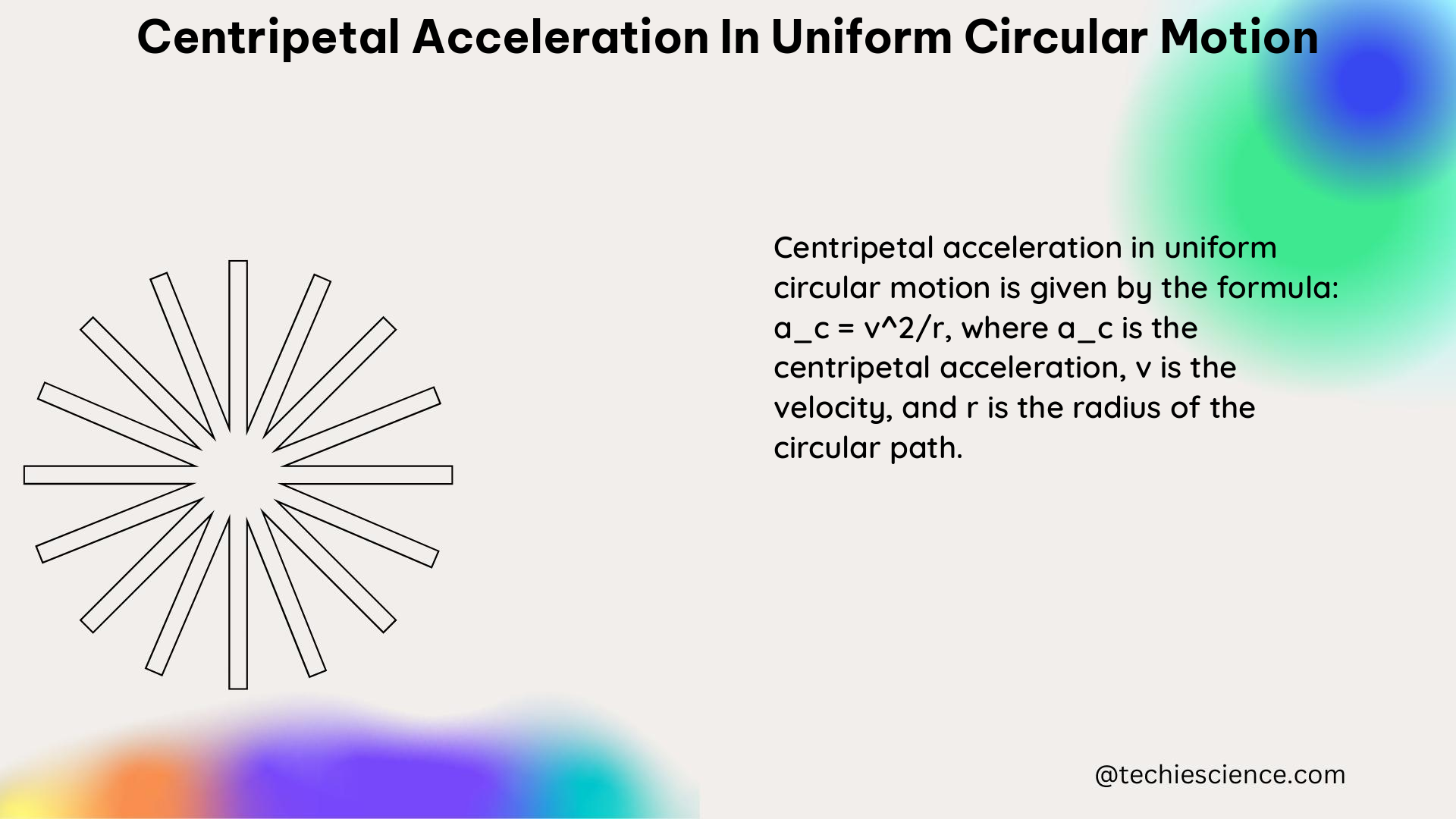Centripetal acceleration is a crucial concept in the study of uniform circular motion, which describes the motion of an object moving in a circular path at a constant speed. This acceleration is directed towards the center of the circular path and is responsible for the object’s change in direction, rather than its speed. Understanding the principles of centripetal acceleration is essential for analyzing the behavior of objects in various applications, from the motion of planets in the solar system to the design of roller coasters.
Understanding Centripetal Acceleration
Centripetal acceleration, denoted as a, is the acceleration experienced by an object moving in a circular path. It is directed towards the center of the circular path and is perpendicular to the object’s velocity. The magnitude of centripetal acceleration can be calculated using the formula:
a = v^2 / r
where v is the tangential velocity of the object and r is the radius of the circular path.
Alternatively, centripetal acceleration can also be calculated using the formula:
a = 4π^2 r / T^2
where T is the period of the circular motion, or the time it takes for the object to complete one full revolution.
Measuring Tangential Velocity

To calculate centripetal acceleration using the first formula, we need to determine the tangential velocity of the object. This can be done using a photo-gate timer and a calculation in LoggerPro software. The tangential velocity v is given by the formula:
v = 2πR / T
where R is the radius of the circular path and T is the time for one complete revolution.
By measuring the time T for one revolution and knowing the radius R, we can calculate the tangential velocity v and then use it to find the centripetal acceleration a.
Calculating Centripetal Force
Once we have the centripetal acceleration, we can calculate the centripetal force F acting on the object using the formula:
F = ma
where m is the mass of the object.
The centripetal force is the force that keeps the object moving in a circular path and is directed towards the center of the circular path.
Examples and Numerical Problems
Let’s consider an example to illustrate the concepts of centripetal acceleration and centripetal force.
Suppose an object is moving in a circular path with a radius of 0.5 meters and completes one revolution in 2 seconds. What is the centripetal acceleration and the centripetal force acting on the object?
Given:
– Radius of the circular path, r = 0.5 m
– Time for one complete revolution, T = 2 s
– Mass of the object, m = 2 kg
Step 1: Calculate the tangential velocity v.
v = 2πR / T
v = 2π × 0.5 / 2 = 1.57 m/s
Step 2: Calculate the centripetal acceleration a.
a = v^2 / r
a = (1.57)^2 / 0.5 = 4.9 m/s^2
Step 3: Calculate the centripetal force F.
F = ma
F = 2 × 4.9 = 9.8 N
Therefore, the centripetal acceleration acting on the object is 4.9 m/s^2, and the centripetal force acting on the object is 9.8 N.
Here’s another example:
A particle is executing uniform circular motion about an axis at a distance of 5.0 m. The particle’s centripetal acceleration is 4.0 m/s^2 at t = 0 s. What is the particle’s velocity at t = 10 s?
Given:
– Radius of the circular path, r = 5.0 m
– Centripetal acceleration at t = 0 s, a = 4.0 m/s^2
– Time, t = 10 s
Step 1: Calculate the tangential velocity v using the formula a = v^2 / r.
v = √(a × r)
v = √(4.0 × 5.0) = 4.47 m/s
Therefore, the particle’s velocity at t = 10 s is 4.47 m/s.
Centripetal Acceleration in Real-World Applications
Centripetal acceleration and centripetal force are fundamental concepts in various fields of physics and engineering. Some real-world applications include:
- Planetary Motion: The motion of planets and other celestial bodies in the solar system is governed by centripetal acceleration due to the gravitational force exerted by the Sun.
- Amusement Park Rides: Centripetal acceleration is crucial in the design of roller coasters and other amusement park rides, ensuring the safety and thrill of the riders.
- Satellite Orbits: Satellites orbiting the Earth experience centripetal acceleration due to the Earth’s gravitational pull, which keeps them in their circular or elliptical orbits.
- Centrifuges: Centrifuges, used in various scientific and medical applications, rely on centripetal acceleration to separate substances based on their density.
- Circular Motion in Machinery: Centripetal acceleration is important in the design and analysis of rotating machinery, such as wheels, gears, and turbines.
Conclusion
Centripetal acceleration is a fundamental concept in the study of uniform circular motion, and understanding its principles is crucial for analyzing the behavior of objects moving in circular paths. By using the formulas for centripetal acceleration and centripetal force, as well as measuring the tangential velocity, we can gain insights into the dynamics of circular motion and apply these concepts to various real-world applications.
References
- Lab 5 – Uniform Circular Motion – WebAssign
- Uniform Circular Motion Flashcards – Quizlet
- 6.2 Uniform Circular Motion – acceleration – Texas Gateway
- Force and Circular Motion | University Physics – Lumen Learning
- Problem 87 A particle’s centripetal acceleration is (a_{m C}=4.0 \, m / s^{2}) at (t=0 \, s). It is executing uniform circular motion about an axis at a distance of (5.0 \, m). What is its velocity at (t=10 \, s) – Vaia
I am Keerthi K Murthy, I have completed post graduation in Physics, with the specialization in the field of solid state physics. I have always consider physics as a fundamental subject which is connected to our daily life. Being a science student I enjoy exploring new things in physics. As a writer my goal is to reach the readers with the simplified manner through my articles.